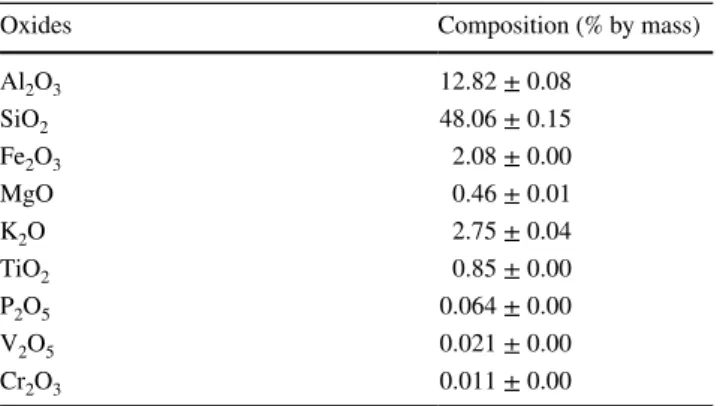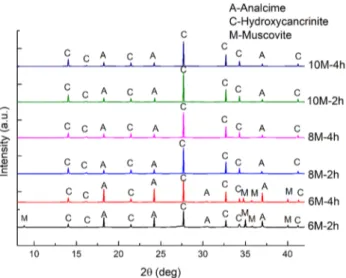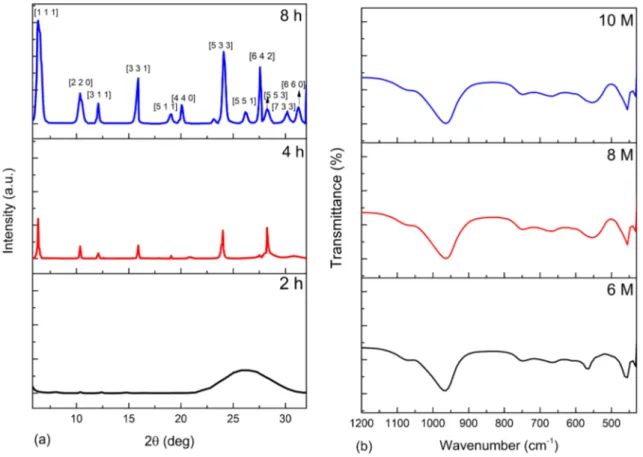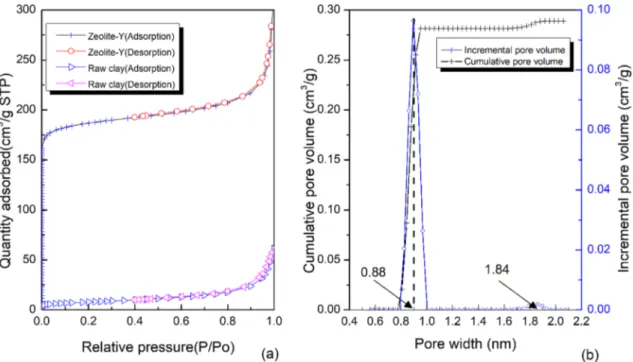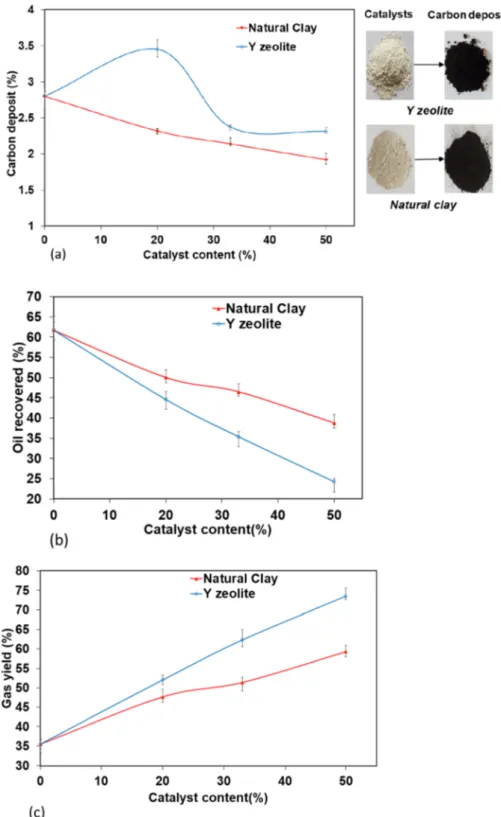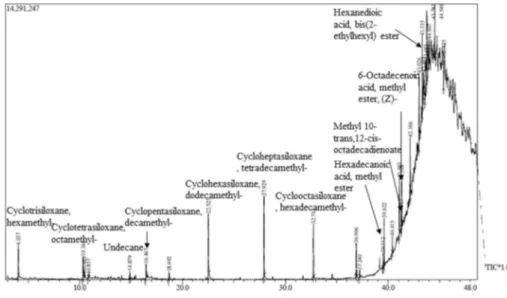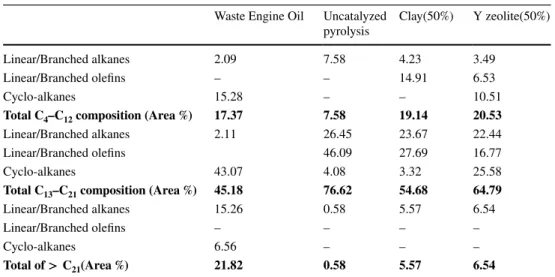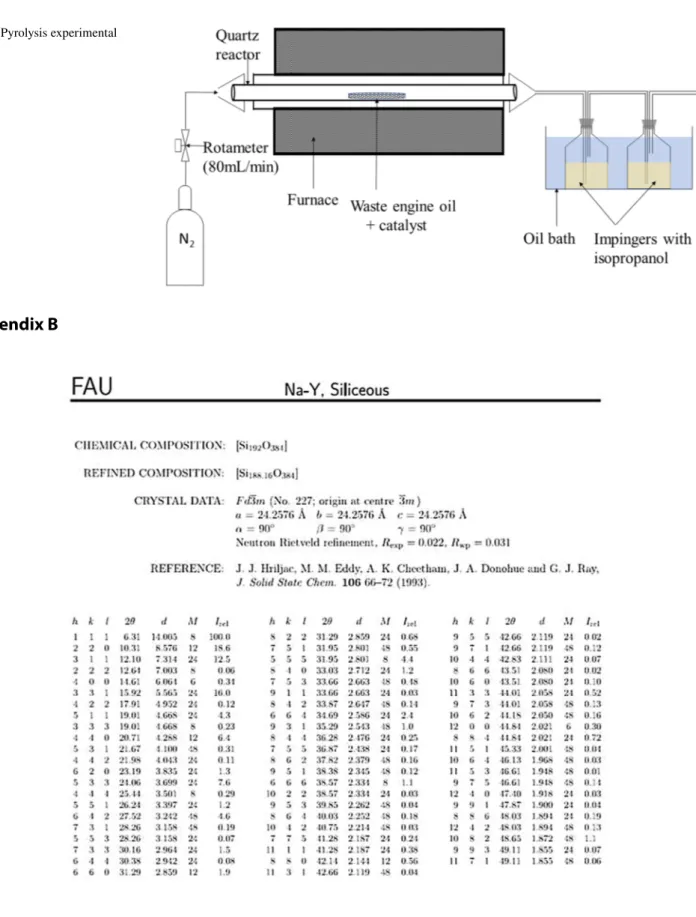HAL Id: hal-02980798
https://hal-mines-albi.archives-ouvertes.fr/hal-02980798
Submitted on 29 Oct 2020
HAL is a multi-disciplinary open access archive for the deposit and dissemination of sci-entific research documents, whether they are pub-lished or not. The documents may come from teaching and research institutions in France or abroad, or from public or private research centers.
L’archive ouverte pluridisciplinaire HAL, est destinée au dépôt et à la diffusion de documents scientifiques de niveau recherche, publiés ou non, émanant des établissements d’enseignement et de recherche français ou étrangers, des laboratoires publics ou privés.
Catalytic Pyrolysis of Waste Engine Oil over Y Zeolite
Synthesized from Natural Clay
Gabriel Kofi Osei, Ange Nzihou, Abu Yaya, Doan Pham Minh, B.
Onwona-Agyeman
To cite this version:
Gabriel Kofi Osei, Ange Nzihou, Abu Yaya, Doan Pham Minh, B. Onwona-Agyeman. Catalytic Pyrolysis of Waste Engine Oil over Y Zeolite Synthesized from Natural Clay. Waste and Biomass Valorization, Springer, In press, �10.1007/s12649-020-01282-0�. �hal-02980798�
Catalytic Pyrolysis of Waste Engine Oil over Y Zeolite Synthesized
from Natural Clay
Gabriel Kofi Osei1,2,3 · Ange Nzihou2 · Abu Yaya1 · Doan Pham Minh2 · B. Onwona‑Agyeman1
Abstract
Cheap alumino-silicate materials such as clay materials and Y zeolite were selected for the catalytic pyrolysis of waste engine oil in a fixed bed reactor. A cheaper route of Y zeolite synthesis involving hydrothermal activation of the raw clay and hydrothermal synthesis was employed. X-ray diffraction technique, scanning electron microscopy, Fourier transform infra-red, and nitrogen desorption method were used to characterize the intermediate phases formed during the hydrothermal treatment of the clay and the synthesized Y zeolite during the hydrothermal processes. The chemical compositions of the liquid phase of catalytic pyrolysis were characterized by gas chromatography coupled with mass spectroscopy (GC–MS). The results revealed that the alkaline concentration strongly influenced the activation of the raw clay to obtain a useful phase for the subsequent synthesis of the Y zeolite. The synthesis improved the surface area from 29 m2/g for the clay to 745 m2/g
for the zeolite. The catalytic pyrolysis resulted in diesel fractions of 64.8 and 54.7%, respectively for the Y zeolite and the clay. It was observed that the gasoline fractions increased to 20.5 and 19.1%, respectively for the zeolite and the clay. In the diesel fraction, the zeolite selectively improved the yield of the cyclo-alkanes which are key constituents in terms of the quality of diesel. Y zeolite was successfully derived from a natural clay and tested in the pyrolysis of waste engine oil. The synthesis route provides the opportunity to improve the catalytic property of the natural clay.
Graphic Abstract
Keywords Waste engine oil · Catalytic pyrolysis · Hydrothermal activation · Y zeolite · Natural clay
Statement of Novelty
Waste engine oil disposal is problematic in developing coun-tries and this is due to the inadequate waste management system. This study investigates the possibility of converting waste engine oil to useful fuels through catalytic pyrolysis. The use of natural clay, which had not been considered in the pyrolysis of waste engine oil before, was explored both as a
* B. Onwona-Agyeman bonwona-agyeman@ug.edu.gh
1 Department of Materials Science and Engineering, School
of Engineering Sciences, University of Ghana, Legon, Ghana
2 Université de Toulouse, Mines Albi, CNRS, Centre
RAPSODEE, Campus Jarlard, 81013 Albi Cedex 09, France
3 Department of Automotive Engineering, Faculty
of Engineering, Koforidua Technical University, Koforidua, Ghana
catalyst and as a raw material for the synthesis of Y zeolite. The hydrothermal process adopted for Y zeolite synthesis prevents the use of chemical reagents which are predominant in the synthesis of alumino-silicate gel. Therefore, the study presents a new perspective for natural clay as a catalyst and as a feedstock for preparing Y zeolite for waste engine val-orisation into useful hydrocarbons.
Introduction
In 2015, the global consumption of lubricating oil was esti-mated at around 35.8 million tons and out of this, about 50% of lubricating oil was converted to waste engine oil [1]. To deal with the waste lubricating oil potential challenge, it is predominantly incinerated or used in combustion processes [2]. However, this approach hinders other forms of tech-nologies of valorisation [1] and due to the adverse impact on the environment and emission control mechanism on the incinerators is required [3, 4]. In some developing coun-tries, waste engine oil is spilled on the ground or dumped in municipal drains or streams [5]. This practice can be very detrimental to the environment since one litre of waste oil is sufficient to contaminate 1 million litres of drinking water [6]. As a result of the potential threat, it is important to con-vert this type of waste into useful hydrocarbons in a sustain-able manner with minimal or no risk to the environment.
Catalytic pyrolysis is one of the technologies that can be used to recover hydrocarbons from waste engine oil since it has the benefit of selectively producing specific organic compounds. The mechanisms of catalytic pyrolysis reactions including those use to eliminate some undesired compounds can be categorised into decarbonylation, decarboxylation, hydrocracking, hydrodeoxygenation and hydrogenation [7–9]. In recent studies, the catalysts that have been used in pyrolysis of waste engine oil include natural magnetite [10], barium-strontium ferrite [11], and zeolites [12]. Some of these studies focused on the influence of the catalysts on the production of diesel fractions while others focus on eliminat-ing oxygenated compounds dureliminat-ing the catalytic pyrolysis.
Zeolites have been extensively used in catalytic pyrolysis and this is because of its ability to selectively catalyse some organic reactions. This ability is derived from the pore struc-ture that gives the catalytic shape-selective behaviour of zeo-lites. On the contrary, alumino-silicate materials such as clay minerals have received less attention in catalysing organic reactions. The reasons include the typical variability of natu-ral clays, wide variety of clay minenatu-rals and, also, the activity and selectivity of clays for cracking organic compounds are lower than that of zeolites [13, 14]. Nonetheless, these rea-sons should no longer suffice to relegate clays as catalysts for hydrocarbon cracking since clays have interesting properties such as Bronsted and Lewis acid sites [15]. Recently, few
studies have reported the application of clays as catalysts in pyrolysis of polypropylene, peat, lignin, almond shell, and wood chips [16–20].
Apart from clay being considered as catalysts, it can serve as alumino-silicate sources for the synthesis of zeolite and this can reduce or eliminate the use of chemical reagents during zeolite synthesis. Using clay in this manner can be viewed as enhancing the catalytic properties of the natural clay. Studies have shown that it is possible to synthesize zeolites such as fujasites, LTA and mordenites frameworks from clay minerals [21–25]. However, the use of chemicals remains as the source of achieving the Si/Al ratio. Also, an appropriate Si/Al composition of clay does not guarantee the synthesis of a particular zeolite [26]. Though Wang et al. [23] have shown that one of the key parameters is Si/Al ratio and this dependency may be attributed to the method of zeolite synthesis.
The catalytic properties of clays in the pyrolysis of waste engine oil have not been investigated yet and, in spite of the plethora of studies of pyrolysis involving zeolites, few studies have employed Y zeolite in the pyrolysis of waste engine oil. Therefore, this study focuses on the synthesis of Y zeolite from a natural clay with a controlled Si/Al molar ratio. Additionally, Y zeolite and the natural clay were inves-tigated in the catalytic pyrolysis of a selected waste engine oil in order to explore a new route for the valorization of this abundant waste.
Materials and Methods
Materials
The natural clay was collected from Anfoega, a town located in the Volta region of Ghana. The lumps of the clay collected were crushed into fine particle sizes. The crushed samples were dried in an oven at 105 °C overnight. The dried clay was sieved and particle sizes less than 50 µm were retained for the synthesis of Y zeolite. Sodium hydroxide (NaOH) pellet (≥ 98.9%) of analytical grade was purchased from Thermo Fisher Scientific and hydrochloric acid (HCl, 37 wt%) was purchased from Chem-Lab (Belgium). The waste engine oil was collected from diesel engines in a garage in Albi city (France).
Methods
Synthesis of Y Zeolite
Y zeolite was synthesized according to the method used by Wang et al. [23]. Approximately 2 g of the natural clay was mixed with 16 mL of 6 M aqueous solution of NaOH. To investigate the impact of the alkaline concentration,
additional experiments were carried out for 8 and 10 M aqueous solution of NaOH. The mixture was then trans-ferred into a 5 mL stainless steel high-pressure autoclave and heated in an oven at a temperature of 240 °C for 2 h. Similar experiments were carried out for 4 and 6 h to investigate the impact of residence time during the activation process in the autoclave. After the activation process, the autoclave was rapidly cooled down with tap water to discontinue any further reaction. The resulting mixture was then decanted and filtered to obtain the solids while the supernatant was recovered and kept for later use. A sample for analyses was prepared from the filtered solids by rinsing with deionized water and continuously centrifuged, after which it was dried in a desiccator for 12 h. The remaining filtered solid materi-als were dispersed in water and vigorously mixed to form a homogeneous slurry. To perform acid dissolution of the solids, a 5 ml solution of 37% HCl was added to the slurry at room temperature. The remaining solids and impurities in the transparent solution were filtered out and rinsed with deionized water and dried in a desiccator for 12 h for further analyses. Consequently, NaOH solution was used to precipi-tate a white gel from the transparent solution obtained from the acid dissolution. The white gel was filtered out of the solution and transferred into the autoclave for hydrothermal crystallization at 90 °C for varied residence times of 2, 6 and 8 h. The resulting solids from this process were washed with deionized water and dried in an oven for 12 h at 105 °C. Catalytic Pyrolysis of Waste Engine Oil
The catalytic pyrolysis of the waste engine oil was per-formed in a horizontal fixed-bed quartz reactor that was electrically heated. The reactor was initially purged with nitrogen at the rate of 80 mL/min and heated to 500 °C. For the non-catalytic pyrolysis, 2 g of waste engine oil was added into an inert ceramic crucible and carefully inserted into the centre of the reactor where the temperature was fixed at 500 °C. Pyrolysis occurs between 300 to 600 °C but typically the boiling point of lubricants is 400 °C [44]. Thus, this limits the range of pyrolysis temperatures between 400 and 600 °C. Increasing the temperature mostly improves the yields of the pyrolysis gases and since the goal of this study is to recover the liquid fuels, this informed the choice of the temperature. Prior to the catalytic pyrolysis, the cata-lysts were dried in an oven at 105 °C to remove any residual moisture. For the catalytic pyrolysis, 2 g of waste engine oil was mixed with the natural clay or Y zeolite (up to 1 g) in an inert ceramic crucible. This latter was quickly inserted into the centre of the reactor. The pyrolysis vapour resulting from the reactor was channelled through two impinger bot-tles containing isopropanol that were fixed in an oil cooler at a temperature of − 5 °C. The solid residue that represents carbon deposition was measured by the difference in the
mass of the crucible together with waste engine oil and cata-lyst before pyrolysis and the mass of crucible together with catalyst and carbon deposit after pyrolysis. The recovered pyrolysis oil was measured by the difference in the mass of impinger bottles with isopropanol before pyrolysis and the mass of impinger bottles with isopropanol and condensed oil after pyrolysis. The yield of the pyrolysis gases was meas-ured by the difference in the mass of the waste engine oil and the masses of the pyrolysis oil and the carbon deposits. Characterization
The crystalline structure of natural clay and Y zeolite was monitored using a Phillips PANalytical X’pert Pro MPD diffractometer with a Cu Kα (1.543 Å) radiation source. In conjunction with the XRD analysis, the morphology of these materials was investigated with the scanning electron microscopy (Philips XL30 ESEM) (SEM). The elemental analysis was carried out with X-ray fluorescence analysis (PANalytical Epsilon 3-XL), while CHNSO analysis was performed by using a Flash 2000 analyzer. Also, Fourier Transform Infrared (FTIR) analysis was carried with a Shi-madzu FTIR 8400 S (resolution of 0.8) spectrometer in the wavenumber range of 4000 to 400 cm−1. The FTIR analysis
was carried out in transmission mode and the number of scans was 10. The textural properties were analyzed with nitrogen adsorption–desorption at 77 K using a Micromer-itics 3Flex apparatus. Before the analysis, samples were degassed at 90 °C for 1 h and the temperature was increased to 150 °C at 5 °C/min and maintained at this temperature for 12 h. The specific areas were determined using the BET method while the micropore surface area and micropore vol-umes were also calculated with t-plot and Horvath-Kawazoe (HK) methods, respectively.
The chemical compositions of the waste engine oil and the pyrolysis oil samples were identified offline using a 6890 GC–MS (Shimadzu).
Statistical Analysis
All the experiments were conducted in triplicates and the results calculated are the averages of the data obtained from the experiment. In addition, standard deviations were also calculated and where necessary in the manuscript, the stand-ard deviations have been displayed.
Results and Discussions
The Natural Clay Characteristics
The chemical compositions of the Anfoega clay are reported in Table 1, while Fig. 1 shows the crystalline structure of the
natural clay. The natural clay was characterised by kaolin-ite (Kaol), muscovkaolin-ite (M), quartz (Q), and montmorillon-ite (Mt). The chemical composition of the raw clay shows that the major oxides present were SiO2 and Al2O3 with respective compositions estimated at 48 and 13% by mass, while the Fe2O3 and K2O contents were around 2% by mass,
respectively. The Si/Al molar ratio of the natural clay was found to be 3.18 and this was sufficient for the Y zeolite syn-thesis. The high molar ratio of Si to Al indicated that there was a high amount of SiO2 in the clay and this was mainly
due to the presence of quartz.
Hydrothermal Alkaline Activation of Clay
Clay is a structured material and this makes the silica and alumina compositions unreactive, therefore, there is a need to activate these compositions. During the activation pro-cess, clay is transformed structurally into zeolitic minerals such as hydroxycancrinite and analcime phases. The levels of alkaline concentration play a crucial role in the phases obtained during the activation of clay through the hydrother-mal process. Wang et al. [23] have shown that lower alkaline concentrations transform the phases in clays to the analcime phase while higher concentrations lead to the hydroxycan-crinite phase. Also, other studies used feldspar [27] and fly ash [28] for the synthesis of hydroxycancrinite and analcime phases and revealed that the formation of these phases is mainly dependent on the levels of alkaline concentration. Understanding the formation of these phases is important since hydroxycancrinite which is acid-soluble is useful in the synthesis of Y zeolite. However, the analcime phase is insoluble in acid medium, therefore, it is not possible to synthesize Y zeolite from analcime.
In view of this, high levels of concentration of NaOH were chosen in the hydrothermal alkaline activation of the clay samples. Additionally, the residence time in the hydro-thermal activation was also varied to investigate its effect on the activation of the clay samples. Table 2, Figs. 2 and
3 show the yields of phase dissolved in the acid medium,
the XRD patterns and SEM images of phases present after hydrothermal activation, respectively. The XRD patterns of the phases were matched according to collection of simu-lated XRD patterns for zeolites [29]. It is shown in Fig. 2
that muscovite (M), hydroxycancrinite (C), and analcime (A) phases were detected after 6 M alkaline activation. The muscovite phase obtained in the reaction was as a result of the remnant of the unreacted muscovite phase contained in the raw clay (Fig. 1), however, the hydroxycancrinite and analcime phases were formed as a result of the hydrother-mal alkaline activation of the clay samples. The increase in alkaline concentration improved the formation of hydroxy-cancrinite while the muscovite phase was not detected at higher concentrations during the hydrothermal activation of the clay. This reinforced the results obtained in Table 2
which shows that the yields of acid-soluble phase, hydrox-ycancrinite, increased from 88.5 to 96% as the alkaline
Table 1 Chemical composition of the natural clay
Oxides Composition (% by mass) Al2O3 12.82 ± 0.08 SiO2 48.06 ± 0.15 Fe2O3 2.08 ± 0.00 MgO 0.46 ± 0.01 K2O 2.75 ± 0.04 TiO2 0.85 ± 0.00 P2O5 0.064 ± 0.00 V2O5 0.021 ± 0.00 Cr2O3 0.011 ± 0.00
Fig. 1 Phase composition of the Anfoega clay
Table 2 Alkaline activation of clay and acid dissolution at different
times and alkaline concentrations Alkaline concentra-tion (M) Alkaline Activation residence time (h)
Yield of acid-soluble phase resulting from alkaline activation (% by mass)
6 2 88.50 ± 0.02 6 4 91.50 ± 0.03 6 6 94.50 ± 0.02 8 2 93.50 ± 0.02 8 4 95.50 ± 0.03 8 6 96.00 ± 0.02 10 2 96.00 ± 0.02 10 4 96.00 ± 0.03 10 6 96.00 ± 0.03
concentration was increased from 6 to 10 M. Also, the SEM images revealed the presence of the unreacted muscovite and hydroxycancrinite after the hydrothermal activation of the clay sample with 6 M concentration of NaOH (Fig. 3a). The muscovite phase exhibits lamellar morphology while the hydroxycancrinite phase exhibits a typical uniform rod mor-phology. This observation confirmed the effect of increasing alkaline concentration on the production of analcime and hydroxycancrinite phases as studied previously [23, 27, 30].
However, the results revealed that further increase in NaOH concentration from 8 to 10 M did not remarkably affect the transformation to hydroxycancrinite and this was due to the formation of the analcime phase as displayed in Fig. 3d.
The effect of residence time was also investigated during the activation process and the results are displayed in Table 2
and Fig. 2. As shown in Table 2, increasing the residence times from 2 to 6 h at 6 M NaOH hydrothermal activation influenced the yields of acid-soluble phase by increasing the yields from 88.5 to 94.5%. However, increasing the resi-dence times at higher concentrations of 8 and 10 M did not influence the yields of the soluble phase. The increase in the yields at 6 M NaOH can be explained by the detection of the unreacted muscovite. The muscovite phase was observed at 6 M alkaline concentration, however, the muscovite phase was not observed when the residence times were varied at higher concentrations phase as displayed in Fig. 2.
Y Zeolite Crystallization
The nucleation and growth of a particular zeolite strongly depend on crystallization temperature and time [26, 31]. Thus, at the beginning of crystallization the starting mate-rial which is gel is amorphous and during the crystalliza-tion process, some crystals of a desired zeolite may begin to form depending on the temperature and time. However, a sustained increase in crystallization time may cause the dis-solution of some zeolites such as zeolite A and zeolite-X into sodalite and zeolite-P, respectively [26]. This phenomenon
Fig. 2 XRD patterns of phases present after alkaline hydrothermal activation of clay samples
Fig. 3 SEM images of hydro-thermal alkaline activated clays for 2 h at varied alkaline concentrations: a 6 M NaOH, b 8 M NaOH, c 10 M NaOH and
makes the zeolites thermodynamically metastable during crystallization. However, a study has shown that crystalli-zation time significantly affects the quality of the zeolite and not the type of zeolite [32]. Similarly, Wang et al. [23] showed that increasing the crystallization time did not affect the type of zeolite produced.
Figure 4a shows the crystallization of the gel formed from the hydrothermal alkaline activation of the clay. The result demonstrated that at the crystallization time of 2 h, the prod-uct remained amorphous with no identifiable reflections. However, as the crystallization time was increased to 4 h, the gel changed from the amorphous state to a crystalline state. Further increase of time to 8 h caused a distinct appear-ance of the reflections which indicated crystallization of the zeolite. The intense reflections at 2θ = 6.3; 10.3; 12.09; 15.9; 24.08; and 27.5 match well with Y zeolite according to collection of simulated XRD patterns for zeolites [29]. The results show that at the crystallization time of 2 h the extracted alumino-silicate material remained amorphous and the nucleation of Y zeolite was yet to commence and at that moment the nucleation and the growth was not avail-able from the gel. After a sustained increase in the crystal-lization time to 4 h, the Y zeolite crystals started to form. The nucleation and growth of the Y zeolite crystals became
pronounced when the crystallization time was increased to 8 h and it also means that the grains began to multiply. The times for which Y zeolite crystallized in this study are remarkable and compare well in the crystallization times obtained by Wang et al. [23].
Further investigations were carried out to examine the properties of Y zeolite crystallized from different gels obtained from the transformation of the clay sample at varying concentrations of 6, 8 and 10 M, respectively, at a constant residence time of 2 h. In Fig. 4b, the three FTIR spectra have similar characteristics with no remarkable dif-ferences. It could be inferred that increasing the concentra-tion during the hydrothermal treatment did not influence the functional groups of the zeolite produced. Also, all the silica and alumina contents were activated and made available for the formation of Y zeolite. The characteristic FTIR bands of the Y zeolite framework occur in the band regions of wave-numbers between 1200 to 400 cm−1 [33, 34]. For the spectra
of the zeolite framework structure, the most prominent bands occur in the ranges of 1250–950 cm−1, 790–650 cm−1, and
500–420 cm−1 [35]. Other bands may occur at 650–500 cm−1
and 420–300 cm−1 [35]. The FTIR prominent band of the
synthesized zeolites occurred between 1000 and 960 cm−1
while the shoulder appeared between 1100 and 1050 cm−1
Fig. 4 Hydrothermal crystallization of gel from the hydrothermal activation of the raw clay; a XRD patterns of crystallized zeolite from 6 M NaOH at different residence times; b FTIR spectra of crystallized Y zeolite at 8 h for 6 M, 8 M and 10 M NaOH
(Fig. 4b). These bands could be attributed to the asymmetric stretching of the Si–O–Al chain in the zeolite structure. The bands at 750 cm−1 and around 675 cm−1, respectively, were
as a result of symmetric stretching modes of TO4 (T = Si or Al) while the bands between 600–550 cm−1 and between 500
and 450 cm−1 were ascribed to external linkage vibrations
and pore opening vibrations, respectively [34, 35].
Table 3 and Fig. 5 show the textural properties, nitro-gen isotherms and pore size distribution of the raw clay and the synthesized Y zeolite. The zeolite exhibited Type 1 reversible adsorption isotherm with a steep rise at low relative pressures (Fig. 5a). This corresponds to micropo-rous material and the filling of narrow micropores [36, 37]. This characteristic of zeolitic material is due to enhanced adsorbent-adsorbate interactions occurring in micropores of molecular dimensions [38]. The physisorption shown by the raw clay was characterized by Type II adsorption isotherm. This corresponds to a non-porous or macroporous adsorbent material which is typical of isotherms exhibited by clays [38]. The synthesis of Y zeolite from the raw clay signifi-cantly enhanced the surface area and micropore volume from 29 m2/g and 0.0016 cm3/g to 745 m2/g and 0.251 cm3/g
respectively (Table 3). The synthesized Y zeolite exhibited a pronounced surface area when compared to synthesized Y zeolite in other studies ranging from 346 to 758 m2/g [23, 34, 36, 37, 39]. Figure 5b shows that the zeolite has two size range micropores-the inner pores of size 0.88 nm and the outer pores 1.84 nm, both corresponding to micropore volume of 0.251 cm3/g.
Catalytic Performance of Zeolite and the Raw Clay in the Pyrolysis of Waste Engine Oil
Effect of Catalysts on Product Yield
The influence of the synthesized Y zeolite and the raw clay was examined during the pyrolysis of waste engine oil and the resultant effects of the catalysts on the pyrolysis product yield are presented in Fig. 6. The catalyst contents influ-enced the decrease in both the carbon deposit and the yield of pyrolysis oil recovered when compared to non-catalytic pyrolysis (0% catalyst in Fig. 6). However, a significant increase in the production of pyrolysis gases was observed as the catalyst contents were increased. The significant increase in gas yields (73%) of the zeolite can be attributed to the microporous nature of the catalyst (see Fig. 5a) and the high surface area of the zeolite (Table 3). This also con-firmed the higher carbon deposits on the zeolite compared with the raw clay which meant that the cracking of waste engine oil was higher on the zeolite. The effect of the high surface area of the zeolites, favouring the gas production during pyrolysis has also been reported by Guimarães et al.
Table 3 Textural properties of the raw clay and Y zeolite
*Calculated by t-plot method; **calculated by Horvath-Kawazoe Textural properties SBET(m2/g) Vmicro(cm3/g)
Raw clay 29 0.001631* Y zeolite 745 0.251**
[40] and Miskolczi et al. [41]. The raw clay favoured the production of pyrolysis oil compared to Y zeolite as shown in Fig. 6 while carbon deposit for that of the clay was found to be lower than that of the zeolite. This may be attributed to the less acidities of the clay compared to the Y zeolite [42] and the presence of water in the clay [43].
Activity and Selectivity of the Catalysts
Table 4 and Fig. 7 show the chemical composition of the waste engine oil and it can be observed that the oil was mainly characterised by paraffinic compounds (84.4%) while the oxygenated and acidic compounds constituted 11.3%. This is typical of lubricating oils from naphthenic base oil
Fig. 6 Influence of catalyst on pyrolysis product yield; a carbon deposit, b pyrolysis oil yield, c gas yield
[44], however, the other compounds found in the waste oil such as hexadecanoic acid methyl ester, methyl 10-trans,12-cis-octadecadienoate, 6-Octadecenoic acid methyl ester, and hexanedioic acid, bis(2-ethylhexyl) ester were formed as a result of oxidation reaction during the service life of the lubricant [45].
The focus of this study was to recover liquid fuel through the catalytic pyrolysis of the waste engine oil, therefore, the chemical composition of the oils was investigated and a comparison was drawn between the catalytic pyrolysis and the non-catalytic pyrolysis. This was done to ascertain the effects of the catalysts on the composition of the oxygen-ated and acidic compounds in the pyrolysis oils. The prod-uct distributions of the non-catalytic and catalytic pyrolysis of the waste engine oil as determined from GC–MS analy-sis are depicted in Fig. 8 and Table 5. It was observed that the main constituents of the non-catalytic pyrolysis of the waste engine include aliphatics, olefins, oxygenated and acidic compounds, and low concentrations of aromatic compounds. The low concentrations of aromatic and oxy-genated compounds identified in the non-catalytic pyrolysis oil can be attributed to their low concentrations originally present in the waste engine oil. Interestingly, it was revealed that the formation of olefins was strongly influenced by the
uncatalyzed pyrolysis of the waste engine oil. Likewise, an increase in the concentration of the n-alkanes was noticed while there was a drastic decrease in the concentration of cyclo-alkanes from 64.9% in the waste engine oil to 4.1% in the uncatalyzed pyrolysis oil. The formation of olefins would be partly as a result of dehydrogenation reaction of the alkanes present in the waste engine oil and this means that unsaturated hydrocarbons were formed from saturated hydrocarbons [12, 46, 47]. Another possible reaction mech-anism for the formation of the olefins could be attributed to the protonation of naphthenes (cyclo-alkanes) to form olefins [48]. The uncatalyzed pyrolysis could not promote deoxygenation reaction as the proportion of the oxygenated compound was found to be 12% (Fig. 8a) and the proportion was almost the same in the waste engine oil.
Similar results of the formation of olefins were found with the zeolite catalytic pyrolysis of the waste engine oil when compared to uncatalyzed pyrolysis. However, the yields of olefins were significantly lower than the uncatalyzed pyroly-sis as depicted in Fig. 8b. In the case of the cyclo-alkanes, the yields were higher when compared with uncatalyzed pyrolysis but the zeolitic pyrolysis yielded lower cyclo-alkanes as compared to the proportion fouØnd in the waste engine oil. It was found that the zeolite promoted the higher yields of the alkanes from 19.5% in the waste engine oil to 32% in the catalysed pyrolysis oil. This revealed that the waste engine oil was selectively cracked to alkanes and ole-fins by the process of dehydrogenation and hydrogenation of the cyclo-alkanes present in the waste engine oil facilitated by the weak Bronsted acid sites associated with the pores of the Y zeolite [12, 49]. It was also observed that the increase in the zeolite proportion during the pyrolysis did not lead to significant commensuration in the yields of the paraffins and the olefins as shown in Fig. 8b. Deoxygenation reaction is very crucial in eliminating oxygenated compounds since
Table 4 Chemical characteristics of the waste engine oil
a Calculated by the difference
Elements
Composi-tion (wt%) Chemical compositions Peak area (%) Carbon 82.7 Alkanes 19.46 Hydrogen 11.61 Cyclo-alkanes 64.91 Nitrogen 0.33 Aromatics 0.42 Sulphur 0.17 Oxygenates and acids 11.3 Oxygena 5.19
Fig. 7 Example of GC–MS analysis of waste engine oil
Fig. 8 Catalytic pyrolysis of oil distributions as obtained from the GCMS analysis; a the composition of the paraffins (alkanes and cycloalkanes), the oxygenated and acidic compounds; b the distribution of the composition of the indi-vidual oxygenated and acidic compounds
Table 5 Carbon chain length of the product distribution of the pyrolysis oil
The bold values are the summations for each groups
Waste Engine Oil Uncatalyzed
pyrolysis Clay(50%) Y zeolite(50%) Linear/Branched alkanes 2.09 7.58 4.23 3.49
Linear/Branched olefins – – 14.91 6.53 Cyclo-alkanes 15.28 – – 10.51
Total C4–C12 composition (Area %) 17.37 7.58 19.14 20.53
Linear/Branched alkanes 2.11 26.45 23.67 22.44 Linear/Branched olefins 46.09 27.69 16.77 Cyclo-alkanes 43.07 4.08 3.32 25.58
Total C13–C21 composition (Area %) 45.18 76.62 54.68 64.79
Linear/Branched alkanes 15.26 0.58 5.57 6.54 Linear/Branched olefins – – – – Cyclo-alkanes 6.56 – – –
these compounds are responsible for the polymerization of hydrocarbons hence making them unstable and acidic during storage [7, 50]. It was found that the addition of the Y zeo-lite promoted deoxygenation reactions and this was evident by the reduction of the oxygenated compounds from 12 to 7.2% in Fig. 8a. This was due to the selective deoxygena-tion of the ethers, esters and decarboxyladeoxygena-tion reacdeoxygena-tion that culminated in the decrease in ethers, esters and carboxylic acids, respectively.
In the case of the clay catalyst, the yields of cyclo-alkanes, linear alkanes and olefins appeared to be unaffected when compared with uncatalyzed pyrolysis as shown in Fig. 8a. On the contrary, there was an increase in the oxygen-ated compounds as the clay catalyst was increased. Kar [19] revealed that some oxygenated compounds increased during the catalytic pyrolysis of almond shell which suggests that clay may not be effective in deoxygenation reaction. In spite of the increase of the oxygenated compounds, a closer look at Fig. 8b showed that the clay catalyst promoted decarboxy-lation. This was evident as the clay catalyst was increased from 20 to 50%. Zafar and Watson [51] have shown decar-boxylation reaction in clay mineral and carboxylic model compounds interaction which showed that the presence of cations in the clay mineral were responsible for the adsorp-tion of carboxylic compounds during the pyrolysis reacadsorp-tion. The influence of the catalysts on the carbon length was investigated to obtain gasoline and diesel fuel fractions in the pyrolysis reaction. Gasoline and diesel fuels contain mixtures of C4–C12 and C13–C21, respectively, while lubri-cants contain a mixture greater than C21 [19, 52, 53]. On
this basis, the pyrolysis oils were categorised as such and the results are illustrated in Table 5. Thermal and catalytic cracking of the heavy hydrocarbons resulted in a significant decrease in the lubricant composition (> C21) from 21% to
0.6, 5.6 and 6.5%, respectively for the uncatalyzed pyroly-sis, clay and the zeolite catalysts. The uncatalyzed pyrolysis favoured the production of C13–C21 that predominantly con-tained linear/branched olefins (46.1%), however, the uncata-lyzed pyrolysis yielded about 7.6% C4–C12. The low yield
of gasoline fraction is typical of non-catalytic pyrolysis of waste engine oil [46, 47]. This showed that the heavy hydro-carbons in the waste engine oil were predominantly cracked into diesel fraction. In the same way, the main compositions of the two catalysed pyrolysis oils were C13–C21, nonethe-less, it was found that the zeolite and clay catalysts signifi-cantly enhanced the production of C4–C12 to 20.5 and 19.1%,
respectively. As part of the C4–C12 and C13–C21
composi-tions, the selectivity of the Y zeolite towards cyclo-alkanes was higher compared to the clay catalyst and this could be as a result of the differences in the micropore volume as shown in Table 3. Cycloalkanes are valuable constituents of diesel fuel since they are prone to ignition [10] and this meant
that the Y zeolite selectively produced suitable C13–C21 as diesel fraction.
Conclusions
Y zeolites were successfully synthesised from natural clay by thermal treatment in an alkaline medium under hydro-thermal conditions. This synthesis route allowed converting up to 96% of the natural clay into Y zeolites. The specific surface area of Y zeolite could reach up to 745 m2/g. The
synthesis route used has significant impact on the energy input compared to metakaolination and fusion methods that are very energy intensive. Also, the use of natural clay in the synthesis provides an avenue to reduce chemical reagents that are predominantly used for the synthesis of zeolites at the industrial scale.
The catalytic performance of the natural clay and Y zeo-lites were then investigated in the catalytic pyrolysis of a waste engine oil in a fixed bed reactor in order to recover useful hydrocarbons. Y zeolite favoured the production of the gaseous hydrocarbons while the natural clay enhanced the production of the liquid phase. It was found that the car-bon deposit was higher on the Y zeolite than on the raw clay. Deoxygenation reactions were observed to be promoted by the Y zeolite and this led to the reduction of the oxygen-ated and acidic compounds such as carboxylic acids, esters, and ethers from 12 to 7%. The raw clay largely increased oxygenated compounds even though there was selective interaction with carboxylic acids that culminated in decar-boxylation reaction.
The yield of the diesel fractions in the catalytic pyrolysis oil using the zeolite and the clay were found to be 65 and 55%, respectively, however, the yields were observed to be lower than the uncatalyzed pyrolysis (77%). The zeolite and clay catalysts enhanced the yields of the gasoline fractions to 21 and 19%, respectively. Some factors for the suitability of diesel fuels depend on chemical compositions and one such factor is ignition delay. Results revealed that the diesel fraction from the Y zeolite catalyst contained cyclo-alkanes which are known to be prone to ignition, thereby, making the diesel fraction more suitable than that obtained with natural clay and the uncatalyzed pyrolysis. This opens a new per-spective for the valorisation of waste engine oil into useful hydrocarbons by catalytic pyrolysis process.
Acknowledgements This work was supported by University of Ghana-Carnegie Corporation of New York through the auspices of ‘Building a New Generation of Academics’ (BANGA-AFRICA) project. The authors acknowledge Elsa Weiss-Hortala and Nathalie Lyczko for allowing this work to be carried out in their laboratories. Also, the authors acknowledge the efforts of Mickael Ribeiro, Christine Rolland and Sylvie Del-Confetto, all of IMT Mines Albi.
Appendix A
See Fig. 9.
Fig. 9 Pyrolysis experimental set-up
Appendix C
See Fig. 10.
References
1. Pinheiro, C.T., Ascensão, V.R., Cardoso, C.M., Quina, M.J., Gando-Ferreira, L.M.: An overview of waste lubricant oil man-agement system: physicochemical characterization contribution for its improvement. J. Clean. Prod. 150, 301–308 (2017). https :// doi.org/10.1016/j.jclep ro.2017.03.024
2. Kupareva, A., Mäki-Arvela, P., Murzin, D.Y.: Technology for rere-fining used lube oils applied in Europe: a review. J. Chem. Tech-nol. BiotechTech-nol. 88, 1780–1793 (2013). https ://doi.org/10.1002/ jctb.4137
3. Tabasová, A., Kropáč, J., Kermes, V., Nemet, A., Stehlík, P.: Waste-to-energy technologies: impact on environment. Energy
44, 146–155 (2012). https ://doi.org/10.1016/j.energ y.2012.01.014
4. Singhabhandhu, A., Tezuka, T.: The waste-to-energy framework for integrated multi-waste utilization: waste cooking oil, waste lubricating oil, and waste plastics. Energy 35, 2544–2551 (2010).
https ://doi.org/10.1016/j.energ y.2010.03.001
5. Mensah-Brown, H.: Re-refining and recycling of used lubricating oil: an option for foreign exchange and natural resource conserva-tion in Ghana. ARPN J. Eng. Appl. Sci. 10, 797–801 (2015). https ://doi.org/10.1002/gsj.1182
6. Submilch, S.: One’s Waste, Another’s Treasure. Hydrocarbon Engineering, March, 141–143 (2019)
7. Mortensen, P.M., Grunwaldt, J.D., Jensen, P.A., Knudsen, K.G., Jensen, A.D.: A review of catalytic upgrading of bio-oil to engine fuels. Appl. Catal. A Gen. 407, 1–19 (2011). https ://doi. org/10.1016/j.apcat a.2011.08.046
8. Dickerson, T., Soria, J.: Catalytic fast pyrolysis: a review. Ener-gies. 6, 514–538 (2013). https ://doi.org/10.3390/en601 0514
9. Nzihou, A., Stanmore, B., Lyczko, N., Minh, D.P.: The catalytic effect of inherent and adsorbed metals on the fast/flash pyrolysis of biomass: a review. Energy. 170, 326–337 (2019). https ://doi. org/10.1016/J.ENERG Y.2018.12.174
10. Khan, R., Ahmad, I., Khan, H., Ismail, M., Gul, K.: Production of diesel-like fuel from spent engine oil by catalytic pyrolysis over natural magnetite. J. Anal. Appl. Pyrolysis. 120, 493–500 (2016).
https ://doi.org/10.1016/j.jaap.2016.06.022
11. Ahmad, I., Khan, R., Ishaq, M., Khan, H., Ismail, M., Gul, K., Ahmad, W.: Valorization of spent lubricant engine oil via catalytic pyrolysis: Influence of barium-strontium ferrite on product distri-bution and composition. J. Anal. Appl. Pyrolysis. (2016). https :// doi.org/10.1016/j.jaap.2016.10.008
12. Tripathi, K.A., Ojha, D.K., Vinu, R.: Selective production of valu-able hydrocarbons from waste motorbike engine oils via catalytic fast pyrolysis using zeolites. J. Anal. Appl. Pyrolysis. 114, 281– 292 (2015). https ://doi.org/10.1016/j.jaap.2015.06.009
13. Lagaly, G., Ogawa, M., Dekany, I.: Clay mineral organic interac-tions. In: Bergaya, F., Lagaly, G. (eds.) Handbook of Clay Science, pp. 309–377. Elsevier Science, Amsterdam (2006)
14. Bergaya, F., Aouad, A., Mandalia, T.: Pillared clays and clay min-erals. In: Bergaya, F., Lagaly, G. (eds.) Handbook of Clay Science, pp. 393–421. Elsevier Science, Amsterdam (2006)
15. Theng, B.K.G.: Clay Mineral Catalysis of Organic Reactions. CRC Press Taylor & Francis Group, LLC, Boca Raton (2018) 16. Hakeem, I.G., Aberuagba, F., Musa, U.: Catalytic pyrolysis of
waste polypropylene using Ahoko kaolin from Nigeria. Appl. Petrochemical Res. 8, 203–210 (2018). https ://doi.org/10.1007/ s1320 3-018-0207-8
17. Sulman, M., Kosivtsov, Y., Sulman, E., Alfyorov, V., Lugovoy, Y., Molchanov, V., Tyamina, I., Misnikov, O., Afanasjev, A., Kumar, N., Murzin, D.: Influence of aluminosilicate materials on the peat low-temperature pyrolysis and gas formation. Chem. Eng. J. 154, 355–360 (2009). https ://doi.org/10.1016/j.cej.2009.04.001
18. Elfadly, A.M., Zeid, I.F., Yehia, F.Z., Abouelela, M.M., Rabie, A.M.: Production of aromatic hydrocarbons from catalytic pyroly-sis of lignin over acid-activated bentonite clay. Fuel Process. Tech-nol. 163, 1–7 (2017). https ://doi.org/10.1016/j.fupro c.2017.03.033
19. Kar, Y.: Catalytic cracking of pyrolytic oil by using bentonite clay for green liquid hydrocarbon fuels production. Biomass Bioenerg. 119, 473–479 (2018). https ://doi.org/10.1016/j.biomb ioe.2018.10.014
20. Veses, A., Aznar, M., López, J.M., Callén, M.S., Murillo, R., García, T.: Production of upgraded bio-oils by biomass catalytic pyrolysis in an auger reactor using low cost materials. Fuel 141, 17–22 (2015). https ://doi.org/10.1016/j.fuel.2014.10.044
21. Belviso, C., Cavalcante, F., Lettino, A., Fiore, S.: A and X-type zeolites synthesised from kaolinite at low temperature. Appl. Clay Sci. 80–81, 162–168 (2013). https ://doi.org/10.1016/j. clay.2013.02.003
22. Musyoka, N.M., Missengue, R., Kusisakana, M., Petrik, L.F.: Conversion of South African clays into high quality zeolites. Appl. Clay Sci. 97, 182–186 (2014). https ://doi.org/10.1016/j. clay.2014.05.026
23. Wang, J.Q., Huang, Y.X., Pan, Y., Mi, J.X.: New hydrothermal route for the synthesis of high purity nanoparticles of zeolite y from kaolin and quartz. Microporous Mesoporous Mater. 232, 77–85 (2016). https ://doi.org/10.1016/j.micro meso.2016.06.010
24. Ayele, L., Pérez-pariente, J., Chebude, Y., Díaz, I.: Conventional versus alkali fusion synthesis of zeolite A from low grade kaolin. Appl. Clay Sci. (2016). https ://doi.org/10.1016/j.clay.2016.07.019
25. Mohiuddin, E., Isa, Y.M., Mdleleni, M.M., Sincadu, N., Key, D., Tshabalala, T.: Synthesis of ZSM-5 from impure and beneficiated Grahamstown kaolin: effect of kaolinite content, crystallisation temperatures and time. Appl. Clay Sci. 119, 213–221 (2016). https ://doi.org/10.1016/j.clay.2015.10.008
26. Johnson, E.B.G., Arshad, S.E.: Hydrothermally synthesized zeo-lites based on kaolinite: a review. Appl. Clay Sci. 97–98, 215–221 (2014). https ://doi.org/10.1016/j.clay.2014.06.005
27. Yuan, J., Yang, J., Ma, H., Liu, C., Zhao, C.: Hydrothermal syn-thesis of analcime and hydroxycancrinite from K-feldspar in Na2SiO3 solution: characterization and reaction mechanism. RSC
Adv. 6, 54503–54509 (2016). https ://doi.org/10.1039/c6ra0 8080d
28. Oh, J.E., Monteiro, P.J.M., Jun, S.S., Choi, S., Clark, S.M.: The evolution of strength and crystalline phases for alkali-activated ground blast furnace slag and fly ash-based geopolymers. Cem. Concr. Res. 40, 189–196 (2010). https ://doi.org/10.1016/j.cemco nres.2009.10.010
29. Treacy, M.M.J., Higgins, J.B.: Collection of Simulated XRD Pow-der Patterns for Zeolites. Elsevier, Amsterdam (2001)
30. Ma, X., Yang, J., Ma, H., Liu, C., Zhang, P.: Synthesis and char-acterization of analcime using quartz syenite powder by alkali-hydrothermal treatment. Microporous Mesoporous Mater. 201, 134–140 (2015). https ://doi.org/10.1016/j.micro meso.2014.09.019
31. Abdullahi, T., Harun, Z., Othman, M.H.: A review on sustainable synthesis of zeolite from kaolinite resources via hydrothermal process. Adv. Powder Technol. 28, 1827–1840 (2017). https ://doi. org/10.1016/j.apt.2017.04.028
32. Caballero, I., Colina, F.G., Costa, J.: Synthesis of X-type zeolite from dealuminated kaolin by reaction with sulfuric acid at high temperature. Ind. Eng. Chem. Res. 46, 1029–1038 (2007) 33. Niwa, M., Katada, N., Okumura, K.: Characterization and Design
of Zeolite Catalysts Solid Acidity, Shape Selectivity and Loading Properties. Springer, Berlin (2010)
34. Charkhi, A., Kazemeini, M., Ahmadi, S.J., Kazemian, H.: Fabrica-tion of granulated NaY zeolite nanoparticles using a new method and study the adsorption properties. Powder Technol. 231, 1–6 (2012). https ://doi.org/10.1016/j.powte c.2012.06.041
35. Karge, H., Hunger, M., Beyer, H.: Characterization of zeolites-infrared and nuclear magnetic resonance spectroscopy and X-ray diffraction. In: Weitkamp, J., Puppe, L. (eds.) Catalysis and Zeo-lites Fundamentals and Applications, pp. 198–326. Springer, Ber-lin (1999)
36. Otieno, S.O., Kengara, F.O., Kemmegne-Mbouguen, J.C., Langmi, H.W., Kowenje, C.B.O., Mokaya, R.: The effects of metakaolini-zation and fused-metakaolinimetakaolini-zation on zeolites synthesized from quartz rich natural clays. Microporous Mesoporous Mater. 290, 109668 (2019). https ://doi.org/10.1016/j.micro meso.2019.10966 8
37. Shilpa, E.R., Gayathri, V.: Encapsulation of Cu(II)[2-(2′-hydroxy-phenyl)benzimidazole]2 within zeolite nano-cavity: structural properties and its catalytic activity towards phenol and styrene oxidation. J. Environ. Chem. Eng. 4, 4194–4206 (2016). https :// doi.org/10.1016/j.jece.2016.09.022
38. Rouquerol, F., Rouquerol, J., Sing, K.S., Llewellyn, P.L., Maurin, G.: Adsorption by Powders and Porous Solids Principles, Meth-odology and Applications. Elsevier, Amsterdam (2014) 39. Bortolatto, L.B., Boca Santa, R.A.A., Moreira, J.C., Machado,
D.B., Martins, M.A.P.M., Fiori, M.A., Kuhnen, N.C., Riella, H.G.: Synthesis and characterization of Y zeolites from alterna-tive silicon and aluminium sources. Microporous Mesoporous Mater. 248, 214–221 (2017). https ://doi.org/10.1016/j.micro meso.2017.04.030
40. Guimarães, J., Fernandes, C., Melo, D., Peres, S., Souza, L.D., Regina, M.: Production of light hydrocarbons from pyrolysis of
heavy gas oil and high density polyethylene using pillared clays as catalysts. J. Anal. Appl. Pyrolysis. 126, 70–76 (2017). https :// doi.org/10.1016/j.jaap.2017.06.023
41. Miskolczi, N., Buyong, F., Angyal, A., Williams, P.T., Bartha, L.: Two stages catalytic pyrolysis of refuse derived fuel: production of biofuel via syncrude. Bioresour. Technol. 101, 8881–8890 (2010).
https ://doi.org/10.1016/j.biort ech.2010.06.103
42. De Stefanis, A., Cafarelli, P., Gallese, F., Borsella, E., Nana, A., Perez, G.: Catalytic pyrolysis of polyethylene: a comparison between pillared and restructured clays. J. Anal. Appl. Pyrolysis.
104, 479–484 (2013). https ://doi.org/10.1016/j.jaap.2013.05.023
43. Dou, G., Goldfarb, J.L.: In situ upgrading of pyrolysis biofuels by bentonite clay with simultaneous production of heterogeneous adsorbents for water treatment. Fuel 195, 273–283 (2017). https ://doi.org/10.1016/j.fuel.2017.01.052
44. Speight, J.G., Exall, D.I.: Refining Used Lubricating Oils. CRC Press, Boca Raton (2014)
45. Rudnick, L.R. (ed.): Lubricant Additives Chemistry and Applica-tions. CRC Press, Boca Raton (2017)
46. Wan Mahari, W.A., Zainuddin, N.F., Chong, C.T., Lee, C.L., Lam, W.H., Poh, S.C., Lam, S.S.: Conversion of waste shipping oil into diesel-like oil via microwave-assisted pyrolysis. J. Envi-ron. Chem. Eng. 5, 5836–5842 (2017). https ://doi.org/10.1016/j. jece.2017.11.005
47. Shiung, S., Keey, R., Kui, C., Chase, H.A.: Catalytic microwave pyrolysis of waste engine oil using metallic pyrolysis char. Appl. Catal B Environ. 176, 601–617 (2015). https ://doi.org/10.1016/j. apcat b.2015.04.014
48. Abrevaya, H.: Cracking of naphtha range alkanes and naphthenes over zeolites. In: From Zeolites to Porous MOF Materials, pp. 1244–1251. Elsevier, Amsterdam (2007)
49. Mante, O.D., Agblevor, F.A., Oyama, S.T., McClung, R.: Catalytic pyrolysis with ZSM-5 based additive as co-catalyst to Y-zeolite in two reactor configurations. Fuel 117, 649–659 (2014). https :// doi.org/10.1016/j.fuel.2013.09.034
50. Bridgwater, A.V.: Review of fast pyrolysis of biomass and prod-uct upgrading. Biomass Bioenerg. 38, 68–94 (2012). https ://doi. org/10.1016/j.biomb ioe.2011.01.048
51. Zafar, R., Watson, J.S.: Adsorption of tetradecanoic acid on kao-linite minerals: using flash pyrolysis to characterise the catalytic efficiency of clay mineral adsorbed fatty acids. Chem. Geol. 471, 111–118 (2017). https ://doi.org/10.1016/j.chemg eo.2017.09.020
52. Speight, J.G.: The Chemistry and Technology of Petroleum. CRC Press, Boca Raton (2014)
53. Ayanoğlu, A., Yumrutaş, R.: Production of gasoline and diesel like fuels from waste tire oil by using catalytic pyrolysis. Energy 103, 456–468 (2016). https ://doi.org/10.1016/j.energ y.2016.02.155
Publisher’s Note Springer Nature remains neutral with regard to jurisdictional claims in published maps and institutional affiliations.

